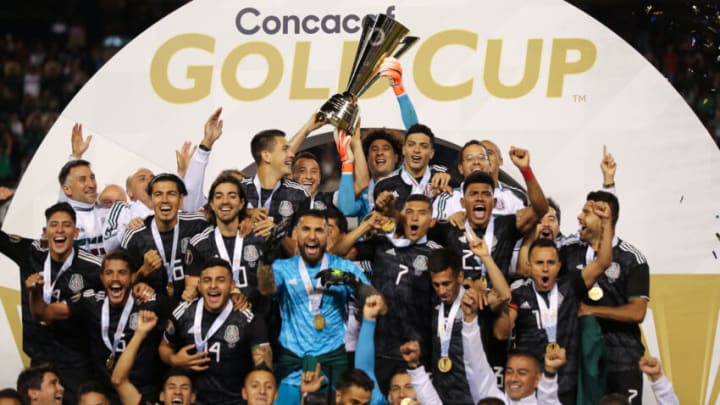
El Tri opens its Gold Cup title defense against Trinidad & Tobago on Saturday night in Arlington, Texas. Team Mexico is a clear favorite to hoist the Copa Oro trophy, even though several first-choice players will be in Tokyo with El Tri Olímpico.
Coach Gerardo Martino worked with Under-23 coach Jaime Lozano to field two competitive teams for the simultaneous tournaments, a task that was made a bit more difficult by injuries and absences.
For instance, Martino was forced to replace captain Andrés Guardado and Rodolfo Pizarro when the pair picked up knocks in training, while Lozano had to find alternatives for striker J.J. Macías and fullback Gerardo Arteaga when they backed out of the Olympic team.
As it is, El Tri should coast through the group stage where they’ll face Curaçao and El Salvador in addition to the Trinidadians. But we’ll concern ourselves with what might happen on the pitch in the next essay.
Double standards: El Tri vs Team USA
As the defending champion and the highest-ranking Concacaf team (Mexico is No. 11 in the FIFA World Rankings, followed by the US at No. 20, Jamaica at No. 45, Costa Rica at No. 50), it’s no surprise that El Tri should be viewed as the favorite.
But their path to the medal stand is made somewhat easier by the U.S. Soccer Federation’s decision to give their top stars a vacation after defeating Mexico in the inaugural Concacaf Nations League final. Only one U.S. player who started in that June 7 final is on the team’s Gold Cup roster, and just two others from that Nations League-winning squad are included in Gregg Berhalter’s list.
More from Playing for 90
- Alexia Putellas reaches 400 games with Barcelona
- Everything you need to know ahead of the 250th ‘Super Clásico’
- Barcelona put five past Real Betis
- Manchester City suffer but come away with win over West Ham
- Baffling Liga MX ruling strips Puebla of a hard-earned victory
Well, that’s their prerogative, you might say. And perhaps it should be, but that’s not the position Concacaf big-wigs took when Mexico sought to rely on alternative line-ups for the Gold Cup.
Mexico began taking part in the Copa América, South America’s regional championship and the world’s second-best regional tournament (behind only the European Championships), in 1993.
El Tri was not just fodder for the big, bad South American clubs. Mexico proved its mettle right from the start, reaching the final that first year and advancing to the semifinals in four of its first five appearances.
El Tri benefited tremendously from this event and Mexico became a familiar face in the FIFA’s top 30, once even climbing into the Top 10, while also earning a top seeding at the 2006 World Cup.
Shortly after the World Cup in 2006, the head honchos of the regional confederation forced Mexico to prioritize Concacaf tournaments. The argument was that other confederation teams would benefit from playing against the region’s best players. The powers-that-be also claimed it was disrespectful for Mexico to use a “B team” or its Under-23 team to compete in the Gold Cup, the regional championship.
El Tri promptly won two consecutive Gold Cups but struggled at the more competitive – and more lucrative – Copa América. By 2016, El Tri was no longer participating in the Copa América.
But now that the United States is sending a “B team,” not a single word from Concacaf about the lack of respect. One standard for the U.S., another standard for Mexico.
Odds and Ends about the two Copas
In 10 Copa América appearances, Mexico reached two finals – losing 2-1 to a Gabriel Batistuta-led Argentina club in 1993, and falling 1-0 to host Colombia in 2001. El Tri also won three third-place medals (1997, 1999, 2007).
In addition to the tougher competition, the Copa América also provides greater revenues. Concacaf offers 1 million dollars to the winner of the Gold Cup whereas the South American tournament provides each participating team 4 million dollars. Yep. Four times the amount of the Gold Cup winner’s purse just for showing up. By the way, the Copa América champion receives 10 million dollars.
You’d think that Mexico would deserve more consideration being that they are far-and-away the top draw. Concacaf expects to rake in about 8-10 million dollars per game when Mexico plays and, if all goes as it should, El Tri will play six games culminating in the Final on Aug. 1.
This year, the Copa América ends the same day the Gold Cup begins (July 10), so it surely seems as though it would have been possible to tweak the schedule to allow Mexico the chance to play in both events.
